 Facebook
Facebook
 X
X
 Instagram
Instagram
 TikTok
TikTok
 Youtube
Youtube
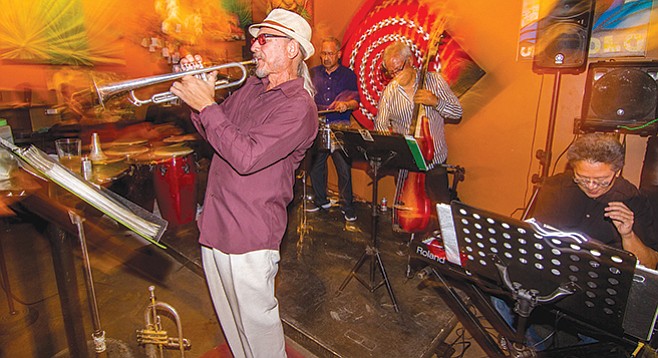
We’re going to have a lot of musicians here tonight, and they all get a turn. Okay?”
A half dozen men circle around a thin man with a top bloom of white hair in long-sleeved plaid and jeans. Strict: “I don’t want this to turn into a mess. Let’s not all take a bunch of endless solos that go on forever.”
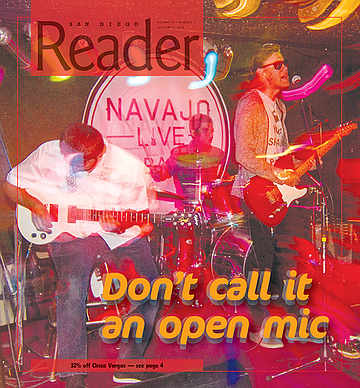
Standing on an otherwise empty dance floor, blue and green stage lights throw long shadows over a mound of band gear arranged like pieces in a puzzle on a stage behind them that is not much bigger than two dinner tables.
“Listen to each other,” the thin man warns, “and keep it about the music.”
It’s jam night at the Kraken in Cardiff. They call it a biker bar and on some weekends it probably still is one. Otherwise, the Kraken — wedged between Highway 101 and the mouth of the San Elijo Lagoon — is an honest, old-school, no-frills road house of a kind that would not get built today. Loud bothers no one here, and the wearing of colors, if a biker is so affiliated, turns no head. But mostly, the Cardiff hang is a music-friendly place for people who like to be seen at a biker bar: a late-night flight of lithe little-black-dresses and their dates who generally arrive en masse, as if the bus from Money Town drops off at the Kraken’s front door.
Robert Cowan is the white-headed man. The septuagenarian plays harmonica, beautifully, the one hand not holding a harp freewheeling in the air of its own accord, as if conducting. Perhaps it is; Cowan runs this rhythm-and-blues jam. He’s seasoned, a pro musician, gigging during his lifetime with musicians as motley as the Strawberry Alarm Clock, Trombone Shorty, Taj Mahal, and Antônio Carlos Jobim.
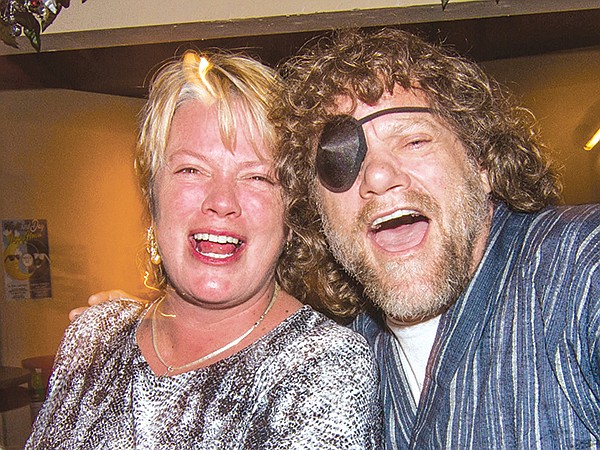
“He preferred that I call him by his nickname,” Cowan says dryly. “Tom.”
But at 9 p.m., the night is still young and the tank-top-and-cargo-shorts crowd hangs back in the Kraken’s far room, shooting pool. Cool sea air blows in through open windows. A half dozen regulars cling to the bar like salt on a margarita. Otherwise, the place is empty.
The opening set of any jam session generally belongs to the house band, which tonight includes Joe Norwood, Dante Fire, Cecil McBee, Cowan, and Frankie Dee. The element of surprise, anted up by the unspoken no-set-list-rule brings out the best in them. Tunes are called and arranged on the fly. Guest jammer Leonard Lee gets called up first.
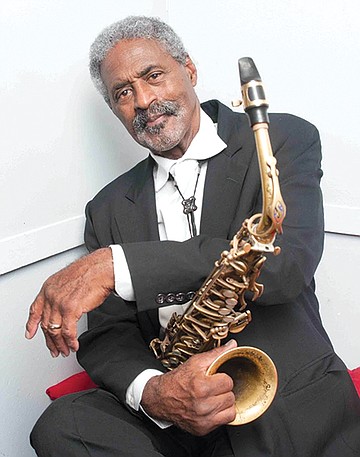
Lee’s a jam regular around town. He chops out some brilliant, quick solos, mindful that he is but one of three guitarists on the stage and that the other two axes, the harmonica, the keys, the bassist, and the sax guy will all want solos. An audience killer? When one song gets turned into a 25-minute ego fest. The seasoned jammer knows this.
Next up to the stage is Chill Boy. Gaunt, eyeglasses enormous on his tanned features, he borrows a guitar. The word is that Chill lives here and there. He takes a quick minute to study the guy’s amplifier settings, adjusts for the tone he wants, and then the band rolls into Delbert McClinton’s version of “Shakey Ground.” His solo is bottomless and fickle and startling and impeccable. The heavens part. The bar flies applaud.
The only problem is that Chill’s solo ends.
If the wellbeing of any given town’s music scene can be gauged by the quantity and the depth of its jam sessions, San Diego is doing middling well. First, an explainer: an open mic is not a jam session. Each is a distinct entity. Open mics are for singer/songwriter original music, and jams cover jazz and blues. Rarely, if ever, do the two universes blend.
Tony Ortega jams jazz at Mr. Peabody’s in Encinitas on Sunday afternoons. Trumpeter/educator Gilbert Castellanos runs a Wednesday-night series at Panama 66 in Balboa Park. Music retailer Sam Ash hosts what may be the town’s only classic rock jam on alternate Sundays. First Tuesdays see a jam of sorts at Pal Joey’s in Allied Gardens. Patrick’s II on random Tuesday nights in the Gaslamp stages a jam; trumpeter Burnett Anderson jams jazz on Wednesdays at Café La Maze in National City; another trumpet player named Gary Rich fronts a jazz jam on the first Thursday of each month at the Bourre Southern Bistro in Rolando; there’s blues jamming going on at the Prohibition Lounge in the Gaslamp on Wednesday evenings; and City College jazz radio 88.3 FM likewise presents a Wednesday-night blues jam at Proud Mary’s restaurant in the Ramada Inn in Kearny Mesa.
Charles McPherson, a jazz alto sax player perhaps best known for his dozen years with the Charles Mingus band during the ’60s and ’70s, has been to more than a few jam sessions in his time. He says there’s camaraderie but that the truer value of jamming is that “it’s a place where you can trade ideas. You can hear what a lot of other people are doing. It’s a learning experience. You learn how to play spontaneously with a group. People are calling tunes out of the air. You’re not necessarily in your comfort zone. But you do it anyway. It’s a musical freefall, and you have to make something out of nothing. To do that, you have to be organized.” He thinks for a beat or two, then says that jamming has a bigger picture. You have to have your feet in both worlds — organized, and free. That’s valuable, because life is like that. You’re free, but you have to have organization.”
Violet-colored light leaks out the doors and onto the sidewalk in front of a green-tiled saloon; inside, a woman sits alone at the bar while men in undershirts shoot pool to music thumping out of a jukebox, cumbia, norteño, whatever. Across the boulevard, low-riders and motorcycles bunch like moths under a dim yellow safety light above a VFW hall. After dark, Logan Avenue turns into an Edward Hopper–scape of shadows and reflections. There are no street lamps down here. What little light there is tonight comes off a waxy harvest moon clearing the horizon, a crowded tiny storefront in which a dozen artists work over canvases, a restaurant, a brewery, and random silvery car headlights. A familiar trumpet melody glides down Logan Avenue. It is Miles Davis’s “So What.”
But all bets are off. This version, emanating from Border X Brewing, swings Latin. At the end of it, Bill Caballero approaches the mic. “I just call the tunes. These guys,” he says of the bassist, the guitarist, and the timbalero standing with him along a back wall, “these guys are the ones who take the music to a different place.”
This is the place where Caballero, band leader and trumpet player, runs his Thursday-night Latin jam. The brewery’s roll-ups are open to the fetid night air. A blonde woman in a black tank-top sits at a window table and undulates to the music like a jellyfish. The venue is packed, and loud. Ceiling fans whirl under Border X’s gilded ceiling.
Caballero calls the old Bobby Hebb tune “Sunny.” The rhythm section makes it quake like something out of War’s back-catalog. A tenor sax, an alto sax, and a trombone player materialize from the shadows. The players seem relatively young. The tenor sax takes a solo, no microphone, his reedy tone puddling around the melody like warm champagne. The blonde drinks beer and undulates some more. The alto sax guy goes next.
He struggles to come up with ideas that flow with the song’s chord progressions. Sounds pretty, but he struggles. When he finishes, he shrugs it off. The trombone player takes third solo. In a gray felt fedora, Caballero, his features steeped in shadow, says something to the alto player — one hopes words of encouragement, not condolence. After all, it wasn’t a bad solo, and in patches here and there, the alto seemed almost weightless against the lunar tug of Caballero’s rhythm section.
Some jam sessions are private, so private you have to know someone to be invited. Like the one at Bob Jones’s house. It’s been going on without fanfare for years, two nights each week, and by now Jones’s Peñasquitos neighbors are used to it. It’s where jazz heavy-hitters go to work out. It’s where Daniel Jackson went to die.
No surprise that the celebrated tenor-sax man landed up here when he reached the end of his rope with cancer. Jackson, a sax player of such renown that the first week in January was named Daniel Jackson week by the San Diego City Council, needed upkeep. Jones had a spare room, and in that way, Jackson passed surrounded by his own kind: jazz musicians of the highest cut.
On any Tuesday or a Thursday evening at the Jones jam, straight-ahead jazz tunes are called by the musicians, solos are assigned round-robin, and starts and endings and bridges are worked and re-worked. There’s camaraderie in the room, but one also gets a sense that there is no messing around.
Jones jammers recall Jackson rallying in a morphine glaze during those last weeks and days and hours of his life, sometimes joining in on piano — too weak to blow any saxophone — until he finally gave out.
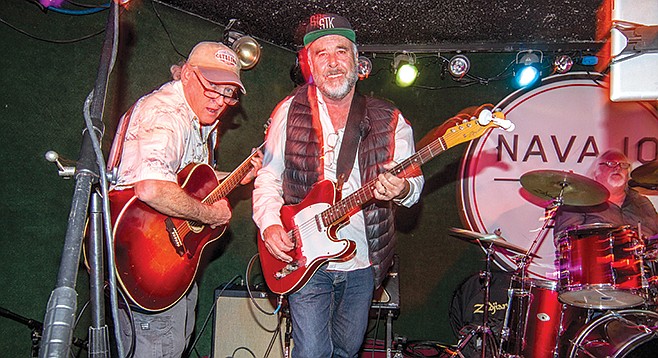
The Thursday-night jam at the Navajo Live Bar, on Navajo Road at Lake Murray Boulevard in Lake Murray, started across town on Sundays at the Parkway Bar. That’s what an auburn singer named Carrie Shannon says, but she has a little skin in the game: her sister owned the Parkway, a La Mesa watering hole that got gobbled up in a development deal. After the Parkway shuttered, those jammers needed a new stage.
“Jeff Ousley,” Shannon says during a smoke break outside the Navajo, “won’t deny that.”
Jeff Ousley fronts the Ballad Mongers band, and he runs the Thursday-night Navajo sessions. “It’s not really a jam,” he cautions when I tell him I’m writing about that scene. “Well, it’s a little of both — a jam, and an open mic.” Which is a rare combination in the jam world; usually, it’s one or the other.
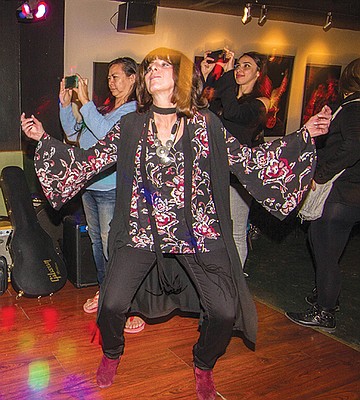
Navajo Live is one of those neighborhood dives granted a new lease on life. A decent crowd tonight — close to 50 clubbers are inside the venue, a mix of musicians and fans, and another dozen or so are outside smoking.
“It’s like this every Thursday,” says Emily Bartell, a 50-ish woman in op-art threads with a craze of black hair, referring to the crowd size. She says she is here tonight to glad-hand and possibly to launch a booking agency using Navajo Live talent.
“I’m re-inventing myself right now.”
For going on three years, Jeff Ousley has put order on the Thursday jam with a sign-up sheet and a table microphone in back. “I can’t believe three songs have gone by,” he announces when the band onstage finishes. The band is fronted by an older man in a straw fedora who plays guitar and sings lead. His original stuff sounds J.J. Cale-ish. “Yep. That’s our three.” The fedora smiles into the stage lights. “You want us to do another one?”
Friendly applause. That’s an up vote. The band winds into their fourth song of the evening.
“A lot of original music gets performed here.” Carrie Shannon snuffs her cigarette. “There’s a featured band, and they get two sets. Thirty minutes. Fifteen minutes is what everybody else gets. That’s about three songs.”
Shannon explains that the difference is that this open mic/jam hybrid provides a full backline (drums and amplifiers) and that there’s a skilled sound guy running the sound system. “Honestly? Whoever shows up, if Jeff can fit them into the schedule, plays.”
All originals?
“No. Sometimes, bands do cover songs.”
Like what, “Freebird”? “Mustang Sally”?
“No.” Jimmy Graham, for example. “You know Jimmy Graham was on the Turko Files, right? He got gypped out of his new teeth. Now he has teeth, and he can play his flute again. He does a lot of Jethro Tull.”
Think fast: Nik Simon calls “Get Back to the Chicken Shack” in the key of G. It’s closing in on 5 p.m. This is the last set of the day at Chet Cannon’s blues jam. But I learned “Chicken Shack” the old Jimmy Smith way, which is in the key of F. I play tenor sax. This means that if I stay and play, I’ll have to transpose the melody on the fly into the new key (which is A for me), and that means the turnaround will have a couple of accidentals (additional sharp or flat notes that are not in the key) that I need to be thinking about. I’m not certain if it would be worse to tank in front of the audience or tank in front of these remarkable musicians.
But then, for some, jamming is all about the risk and a fear of failure that goes all the way back to the 1930s when a teenaged saxist named Charlie Parker famously got himself thrown off a stage for sucking. Then again, in Parker’s day, jams were peopled by gatekeepers of merit who demanded the very jazz best. If a player train-wrecked (that’s what we call it when the music doesn’t work), he/she was politely asked to step down. Which doesn’t happen so much at jams here.
For many, the weekly jam is the only place to get stage time. Some jammers seem content to play the same songs week after week. But there’s another reason a fan might hear a lot of “Stormy Monday” and “Red House” and “Thrill Is Gone” at blues jams: much of the time, it comes down to finding songs that all of the jammers in a given set know.
Cannon’s jam is a blues tradition going a dozen years strong at the Downtown Café in El Cajon. It draws a variety of players, from weekend warriors to pros. This jam has also fostered some young players who have since gone on to various degrees of music careers: Wyatt Lowe, Leilani Kilgore, Anthony Cullins, and Serena Geroe are names that come to mind.
An imposing guitarist with a full sleeve down one arm, Simon has partnered up today with a capable electric slide guitarist, a first-call bassist, and an eminent drummer. I am in way over my head. If all goes according to the unspoken plan, the two guitars and I will play the “Chicken Shack” melody in unison.
Am I nervous? No. Aware, but not nervous. Aware of Nik Simon’s movements, aware of the vibe of the band chatter, aware of the wave of late-day energy coming off the audience, and all of that transiting with the musical footnotes that are my immediate focus. My old sax teacher’s stern voice suddenly surfaces in there somewhere: “Make every damned note mean something!” Just then, Simon looks over his shoulder at the band, and he counts us in and just like that, his large, reassuring guitar tone reaches through his amplifier and envelops the set like a warm blanket. I step up to the microphone, shut my eyes, take a huge breath, and blow.


We’re going to have a lot of musicians here tonight, and they all get a turn. Okay?”
A half dozen men circle around a thin man with a top bloom of white hair in long-sleeved plaid and jeans. Strict: “I don’t want this to turn into a mess. Let’s not all take a bunch of endless solos that go on forever.”

Standing on an otherwise empty dance floor, blue and green stage lights throw long shadows over a mound of band gear arranged like pieces in a puzzle on a stage behind them that is not much bigger than two dinner tables.
“Listen to each other,” the thin man warns, “and keep it about the music.”
It’s jam night at the Kraken in Cardiff. They call it a biker bar and on some weekends it probably still is one. Otherwise, the Kraken — wedged between Highway 101 and the mouth of the San Elijo Lagoon — is an honest, old-school, no-frills road house of a kind that would not get built today. Loud bothers no one here, and the wearing of colors, if a biker is so affiliated, turns no head. But mostly, the Cardiff hang is a music-friendly place for people who like to be seen at a biker bar: a late-night flight of lithe little-black-dresses and their dates who generally arrive en masse, as if the bus from Money Town drops off at the Kraken’s front door.
Robert Cowan is the white-headed man. The septuagenarian plays harmonica, beautifully, the one hand not holding a harp freewheeling in the air of its own accord, as if conducting. Perhaps it is; Cowan runs this rhythm-and-blues jam. He’s seasoned, a pro musician, gigging during his lifetime with musicians as motley as the Strawberry Alarm Clock, Trombone Shorty, Taj Mahal, and Antônio Carlos Jobim.

“He preferred that I call him by his nickname,” Cowan says dryly. “Tom.”
But at 9 p.m., the night is still young and the tank-top-and-cargo-shorts crowd hangs back in the Kraken’s far room, shooting pool. Cool sea air blows in through open windows. A half dozen regulars cling to the bar like salt on a margarita. Otherwise, the place is empty.
The opening set of any jam session generally belongs to the house band, which tonight includes Joe Norwood, Dante Fire, Cecil McBee, Cowan, and Frankie Dee. The element of surprise, anted up by the unspoken no-set-list-rule brings out the best in them. Tunes are called and arranged on the fly. Guest jammer Leonard Lee gets called up first.

Lee’s a jam regular around town. He chops out some brilliant, quick solos, mindful that he is but one of three guitarists on the stage and that the other two axes, the harmonica, the keys, the bassist, and the sax guy will all want solos. An audience killer? When one song gets turned into a 25-minute ego fest. The seasoned jammer knows this.
Next up to the stage is Chill Boy. Gaunt, eyeglasses enormous on his tanned features, he borrows a guitar. The word is that Chill lives here and there. He takes a quick minute to study the guy’s amplifier settings, adjusts for the tone he wants, and then the band rolls into Delbert McClinton’s version of “Shakey Ground.” His solo is bottomless and fickle and startling and impeccable. The heavens part. The bar flies applaud.
The only problem is that Chill’s solo ends.
If the wellbeing of any given town’s music scene can be gauged by the quantity and the depth of its jam sessions, San Diego is doing middling well. First, an explainer: an open mic is not a jam session. Each is a distinct entity. Open mics are for singer/songwriter original music, and jams cover jazz and blues. Rarely, if ever, do the two universes blend.
Tony Ortega jams jazz at Mr. Peabody’s in Encinitas on Sunday afternoons. Trumpeter/educator Gilbert Castellanos runs a Wednesday-night series at Panama 66 in Balboa Park. Music retailer Sam Ash hosts what may be the town’s only classic rock jam on alternate Sundays. First Tuesdays see a jam of sorts at Pal Joey’s in Allied Gardens. Patrick’s II on random Tuesday nights in the Gaslamp stages a jam; trumpeter Burnett Anderson jams jazz on Wednesdays at Café La Maze in National City; another trumpet player named Gary Rich fronts a jazz jam on the first Thursday of each month at the Bourre Southern Bistro in Rolando; there’s blues jamming going on at the Prohibition Lounge in the Gaslamp on Wednesday evenings; and City College jazz radio 88.3 FM likewise presents a Wednesday-night blues jam at Proud Mary’s restaurant in the Ramada Inn in Kearny Mesa.
Charles McPherson, a jazz alto sax player perhaps best known for his dozen years with the Charles Mingus band during the ’60s and ’70s, has been to more than a few jam sessions in his time. He says there’s camaraderie but that the truer value of jamming is that “it’s a place where you can trade ideas. You can hear what a lot of other people are doing. It’s a learning experience. You learn how to play spontaneously with a group. People are calling tunes out of the air. You’re not necessarily in your comfort zone. But you do it anyway. It’s a musical freefall, and you have to make something out of nothing. To do that, you have to be organized.” He thinks for a beat or two, then says that jamming has a bigger picture. You have to have your feet in both worlds — organized, and free. That’s valuable, because life is like that. You’re free, but you have to have organization.”
Violet-colored light leaks out the doors and onto the sidewalk in front of a green-tiled saloon; inside, a woman sits alone at the bar while men in undershirts shoot pool to music thumping out of a jukebox, cumbia, norteño, whatever. Across the boulevard, low-riders and motorcycles bunch like moths under a dim yellow safety light above a VFW hall. After dark, Logan Avenue turns into an Edward Hopper–scape of shadows and reflections. There are no street lamps down here. What little light there is tonight comes off a waxy harvest moon clearing the horizon, a crowded tiny storefront in which a dozen artists work over canvases, a restaurant, a brewery, and random silvery car headlights. A familiar trumpet melody glides down Logan Avenue. It is Miles Davis’s “So What.”
But all bets are off. This version, emanating from Border X Brewing, swings Latin. At the end of it, Bill Caballero approaches the mic. “I just call the tunes. These guys,” he says of the bassist, the guitarist, and the timbalero standing with him along a back wall, “these guys are the ones who take the music to a different place.”
This is the place where Caballero, band leader and trumpet player, runs his Thursday-night Latin jam. The brewery’s roll-ups are open to the fetid night air. A blonde woman in a black tank-top sits at a window table and undulates to the music like a jellyfish. The venue is packed, and loud. Ceiling fans whirl under Border X’s gilded ceiling.
Caballero calls the old Bobby Hebb tune “Sunny.” The rhythm section makes it quake like something out of War’s back-catalog. A tenor sax, an alto sax, and a trombone player materialize from the shadows. The players seem relatively young. The tenor sax takes a solo, no microphone, his reedy tone puddling around the melody like warm champagne. The blonde drinks beer and undulates some more. The alto sax guy goes next.
He struggles to come up with ideas that flow with the song’s chord progressions. Sounds pretty, but he struggles. When he finishes, he shrugs it off. The trombone player takes third solo. In a gray felt fedora, Caballero, his features steeped in shadow, says something to the alto player — one hopes words of encouragement, not condolence. After all, it wasn’t a bad solo, and in patches here and there, the alto seemed almost weightless against the lunar tug of Caballero’s rhythm section.
Some jam sessions are private, so private you have to know someone to be invited. Like the one at Bob Jones’s house. It’s been going on without fanfare for years, two nights each week, and by now Jones’s Peñasquitos neighbors are used to it. It’s where jazz heavy-hitters go to work out. It’s where Daniel Jackson went to die.
No surprise that the celebrated tenor-sax man landed up here when he reached the end of his rope with cancer. Jackson, a sax player of such renown that the first week in January was named Daniel Jackson week by the San Diego City Council, needed upkeep. Jones had a spare room, and in that way, Jackson passed surrounded by his own kind: jazz musicians of the highest cut.
On any Tuesday or a Thursday evening at the Jones jam, straight-ahead jazz tunes are called by the musicians, solos are assigned round-robin, and starts and endings and bridges are worked and re-worked. There’s camaraderie in the room, but one also gets a sense that there is no messing around.
Jones jammers recall Jackson rallying in a morphine glaze during those last weeks and days and hours of his life, sometimes joining in on piano — too weak to blow any saxophone — until he finally gave out.

The Thursday-night jam at the Navajo Live Bar, on Navajo Road at Lake Murray Boulevard in Lake Murray, started across town on Sundays at the Parkway Bar. That’s what an auburn singer named Carrie Shannon says, but she has a little skin in the game: her sister owned the Parkway, a La Mesa watering hole that got gobbled up in a development deal. After the Parkway shuttered, those jammers needed a new stage.
“Jeff Ousley,” Shannon says during a smoke break outside the Navajo, “won’t deny that.”
Jeff Ousley fronts the Ballad Mongers band, and he runs the Thursday-night Navajo sessions. “It’s not really a jam,” he cautions when I tell him I’m writing about that scene. “Well, it’s a little of both — a jam, and an open mic.” Which is a rare combination in the jam world; usually, it’s one or the other.

Navajo Live is one of those neighborhood dives granted a new lease on life. A decent crowd tonight — close to 50 clubbers are inside the venue, a mix of musicians and fans, and another dozen or so are outside smoking.
“It’s like this every Thursday,” says Emily Bartell, a 50-ish woman in op-art threads with a craze of black hair, referring to the crowd size. She says she is here tonight to glad-hand and possibly to launch a booking agency using Navajo Live talent.
“I’m re-inventing myself right now.”
For going on three years, Jeff Ousley has put order on the Thursday jam with a sign-up sheet and a table microphone in back. “I can’t believe three songs have gone by,” he announces when the band onstage finishes. The band is fronted by an older man in a straw fedora who plays guitar and sings lead. His original stuff sounds J.J. Cale-ish. “Yep. That’s our three.” The fedora smiles into the stage lights. “You want us to do another one?”
Friendly applause. That’s an up vote. The band winds into their fourth song of the evening.
“A lot of original music gets performed here.” Carrie Shannon snuffs her cigarette. “There’s a featured band, and they get two sets. Thirty minutes. Fifteen minutes is what everybody else gets. That’s about three songs.”
Shannon explains that the difference is that this open mic/jam hybrid provides a full backline (drums and amplifiers) and that there’s a skilled sound guy running the sound system. “Honestly? Whoever shows up, if Jeff can fit them into the schedule, plays.”
All originals?
“No. Sometimes, bands do cover songs.”
Like what, “Freebird”? “Mustang Sally”?
“No.” Jimmy Graham, for example. “You know Jimmy Graham was on the Turko Files, right? He got gypped out of his new teeth. Now he has teeth, and he can play his flute again. He does a lot of Jethro Tull.”
Think fast: Nik Simon calls “Get Back to the Chicken Shack” in the key of G. It’s closing in on 5 p.m. This is the last set of the day at Chet Cannon’s blues jam. But I learned “Chicken Shack” the old Jimmy Smith way, which is in the key of F. I play tenor sax. This means that if I stay and play, I’ll have to transpose the melody on the fly into the new key (which is A for me), and that means the turnaround will have a couple of accidentals (additional sharp or flat notes that are not in the key) that I need to be thinking about. I’m not certain if it would be worse to tank in front of the audience or tank in front of these remarkable musicians.
But then, for some, jamming is all about the risk and a fear of failure that goes all the way back to the 1930s when a teenaged saxist named Charlie Parker famously got himself thrown off a stage for sucking. Then again, in Parker’s day, jams were peopled by gatekeepers of merit who demanded the very jazz best. If a player train-wrecked (that’s what we call it when the music doesn’t work), he/she was politely asked to step down. Which doesn’t happen so much at jams here.
For many, the weekly jam is the only place to get stage time. Some jammers seem content to play the same songs week after week. But there’s another reason a fan might hear a lot of “Stormy Monday” and “Red House” and “Thrill Is Gone” at blues jams: much of the time, it comes down to finding songs that all of the jammers in a given set know.
Cannon’s jam is a blues tradition going a dozen years strong at the Downtown Café in El Cajon. It draws a variety of players, from weekend warriors to pros. This jam has also fostered some young players who have since gone on to various degrees of music careers: Wyatt Lowe, Leilani Kilgore, Anthony Cullins, and Serena Geroe are names that come to mind.
An imposing guitarist with a full sleeve down one arm, Simon has partnered up today with a capable electric slide guitarist, a first-call bassist, and an eminent drummer. I am in way over my head. If all goes according to the unspoken plan, the two guitars and I will play the “Chicken Shack” melody in unison.
Am I nervous? No. Aware, but not nervous. Aware of Nik Simon’s movements, aware of the vibe of the band chatter, aware of the wave of late-day energy coming off the audience, and all of that transiting with the musical footnotes that are my immediate focus. My old sax teacher’s stern voice suddenly surfaces in there somewhere: “Make every damned note mean something!” Just then, Simon looks over his shoulder at the band, and he counts us in and just like that, his large, reassuring guitar tone reaches through his amplifier and envelops the set like a warm blanket. I step up to the microphone, shut my eyes, take a huge breath, and blow.
Comments